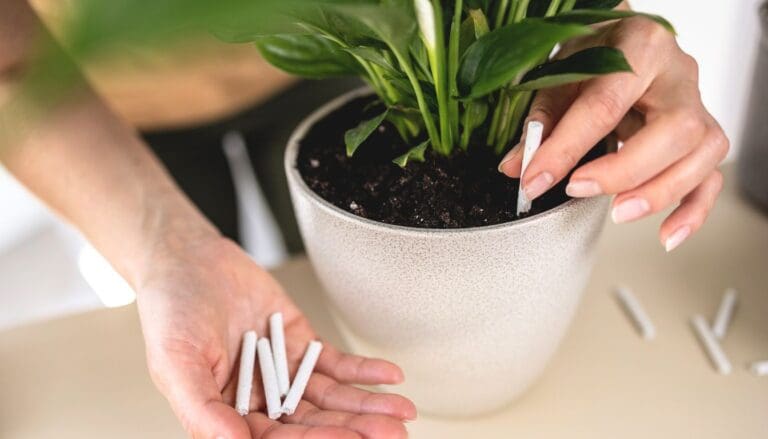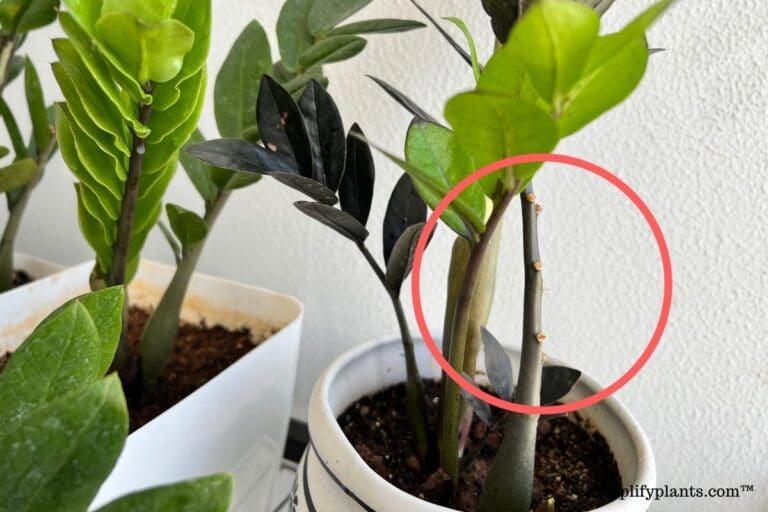How To Prune English Ivy? (Best Time+Tips To Follow)
English ivy is a beautiful evergreen plant loved for its beautiful glossy leaves and easy requirements. However, these can grow vigorously, and not pruning can make them uneven and even leggy. So, how to prune English ivy? Let’s understand.
To prune your English ivy:
- Take a sharp and sterilized pair of scissors.
- Always Wear gloves to avoid any skin irritation.
- Take the long trails and cut right above the nodes.
- You can also pinch the vine right above a leaf.
- Propagate the cuttings if you need more.
- Else, dispose of the cutting properly.
Prune all the overgrowth, long and leggy stems, and damaged parts of your English ivy.
Be careful while pruning, as an uneven cut can damage the plant and prevent its growth. In this article, I will discuss how to prune an English ivy and everything you need to know.

Please note: Simplify Plants is reader-supported. Some links in the post are affiliate links and I get a commission from purchases made through links in the post.
Should I cut back my English ivy?
Yes, you should cut back your English ivy, or it will grow uneven, leggy, and take a shape you don’t like.
All houseplants need pruning, and it is no different for English ivy.
When English ivy grows in its natural habitat, it has all the space in the world, so it doesn’t require any pruning.
But when growing it in the house or garden, you wouldn’t want it to overgrow and start looking messy.
Therefore, pruning becomes crucial and a regular part of the plant’s care routine.
With that being said, let’s look at all the benefits of pruning your English ivy plant.
1. Pruning keeps the ivy in shape
English ivy shows aggressive growth when it gets suitable growing conditions.
If you are providing all the correct requirements for your English ivy, it will grow fast and cover more space than your liking.
If you don’t prune, your English ivy will overgrow and ruin the aesthetics of the space.
Therefore, if you want to keep your English ivy in shape, prune it from time to time.
2. Pruning removes the dead and damaged parts
All plants have dead leaves, damaged stems, and diseased parts in case it has pests or diseases.
These are unnecessary parts that waste the plant’s energy.
The diseased parts can even spread to the healthy parts and make the entire plant unhealthy.
Not pruning these parts will slow the plant’s growth, make it look dull, or even threaten its health.
Therefore, prune these parts whenever you notice them in your English ivy.
This will save the plant’s energy which it can focus on producing new growth.
3. Pruning boosts the growth of the English ivy
One hack to boost your English ivy’s growth, other than feeding it with a high-nitrogen fertilizer, is to prune it.
If your English ivy is not growing as fast as you want, you can prune it severely.
This will boost the growth hormone and help your English ivy grow faster.
4. Pruning makes your English ivy bushier
Since pruning the English ivy boosts its growth hormone, you can prune it to make it bushier.
It is common for people’s English ivy plants to grow bushy on one side and show less growth on the other.
In these cases, pruning the sides that don’t show as much growth can make them grow bushier.
When you prune the plant, it releases growth hormone from the sides you prune.
This growth hormone allows the plant to grow more on those sides.
Instead of pruning, you can also try pinching in such scenarios.
5. Pruning changes the growth of the direction of the English ivy
Is your English ivy growing in a direction that you don’t want?
You can change the direction of its growth by pruning it!
If your English ivy is getting light on one side and not getting enough on the other, the former will grow more and create an uneven look.
But, you can prune the side with more growth to match it with the other side.
This way, you will create an even look for your English ivy.
Keep rotating the plant, so this issue doesn’t occur again.
When Should English ivy be cut back?
Your English ivy will need pruning at least once every year, depending on how vigorous its growth is.
You can light prune your English ivy several times a year.
But if you want to prune your English ivy heavily, do it before spring arrives.
The plant starts growing fast during spring and focuses on new growth, so pruning right before that will help eliminate all the unrequired parts.
What to prune in your English ivy?

The next question is which parts of the plant will require pruning.
Here are all the parts that you can prune:
- Yellow leaves
- Brown leaves
- Leggy trails with few leaves that are longer than other parts.
- Parts that have a group of pests if your English ivy is pest infested.
- Dead and broken vines.
- Soft and mushy roots if there’s root rot or other fungal diseases.
- The crowded growth disrupts proper airflow.
- The tips of the vines for bushier growth.
- Top of the vines to prevent overgrowth.
- Vines with plain leaves with no variegation if you have a variegated English ivy.
How do you prune an English ivy plant?
Now that you know why, when, and which parts of the English ivy you can prune, it is time to understand the process.
Pruning an English ivy plant is nothing complicated but make sure you do it carefully to avoid damaging the plant.
Supplies you will need:
- Your English ivy
- Disinfectant
- Sharp pruners or garden shears
Always sterilize the pruner with a disinfectant before and after use to prevent the spread of germs.
Here is the step-by-step process of pruning an English ivy:
1. Inspect the ivy and find the parts that need pruning.
Before pruning your English ivy, start by thoroughly inspecting the plant.
This will ensure you know where you want to make the cuts and won’t go overboard.
Inspect and mark the areas in your mind that you want to prune.
You can consider the leggy parts, dead foliage, diseased parts, etc.
2. Start by removing the dead parts

If you find dead leaves and vines on your English ivy, prune them first.
If you notice stems that have died from the base, you can gently pull them out instead of pruning them.
These might be affected by root rot or any other disease.
Don’t forget to discard these.
3. Prune the unhealthy parts
One of the common problems with English ivy plants is leggy vines.
If you notice stems that are too long, weak, and have very few leaves on them, prune them off.
Also, prune the yellow, brown, and discolored leaves.
These waste the plant’s energy that the plant can use for new and healthy growth.
So, it is best to prune these.
4. Prune the overgrowth and boost new growth
English ivy can overgrow and become bushy in very little time, leading to overgrowth and a messy look if you don’t prune the plant.
Prune these parts.
Pruning also helps you make your English ivy bushier.
When you prune right above a leaf node, you will notice fresh growth coming out of it.
5. Prune to propagate your English ivy

When you prune your English ivy, you get many parts you can propagate instead of throwing them away.
This way, you can get new English ivy plants without buying them.
If you are pruning your English ivy for propagation, cut right above the leaf node so the roots can emerge.
Make sure the vines are at least 3-6 inches long.
After getting the cutting, you can place it in water and soil for propagation.
Tips for pruning your English ivy
Here are some tips to help you prune your English ivy without any error.
- Always disinfect the pruners or scissors before and after use so germs can’t spread from one plant to another.
- If you are pinching the English ivy to boost growth, wear gloves as you might experience skin irritation otherwise.
- Avoid pruning more than 25% at once as that can stress the ivy.
- Prune at a 45-degree angle and make sure the cuts are clean. Use sharp pruners for cutting.
- Water your English ivy after pruning it to reduce the stress.
- Avoid pruning in winter as the plant reduces its growth during this time. Pruning during this time will put the plant under more stress.
What happens if I don’t trim your English ivy?
Pruning is an important part of the plant care routine for a reason.
Houseplants don’t have enough space or the most favorable conditions all the time to grow freely.
If you don’t prune your English ivy, you will notice:
- Crowded growth
- Uneven growth
- Legginess
- Slow growth
Therefore, don’t avoid pruning as it is an easy process, and you don’t need to do it too frequently.
Final thoughts
English ivy can grow fast when it gets favorable growing conditions. If you want your English ivy to remain healthy and aesthetic, don’t sleep on pruning it.
The best time to prune an English ivy is right before spring arrives. Use a sharp, sterilized pruner to prune the leggy, dead, diseased parts and overgrowth. Also, prune to boost the growth of the plant.
Be careful while pruning, and don’t prune during the winter season.
Reference: Researchgate, University of Tennessee, Mississippi State University, Central Florida Research and Education Center, U.S. DEPARTMENT OF AGRICULTURE.
Recommended Garden Supplies
| Product Image | Our Recommended Gardening Supplies | Check Offers! |
|---|---|---|
Top Top
Top
Top
Top
Top
Top
Top
Top | rePotme Houseplant and Tropical Classic Potting Soil Mix | Check Offer On Amazon |
 Top
Top
Top
Top
Top
Top
Top
Top | Espoma Organic Indoor Plant Food | Check Offer On Amazon |
 Top
Top
Top
Top
Top
Top
Top
Top | GooingTop LED Grow Light 6000K Full Spectrum Clip Plant Growing Lamp | Check Offer On Amazon |
 Top
Top
Top
Top
Top
Top
Top
Top | Soil Moisture Meter | Check Offer On Amazon |
 Top
Top
Top
Top
Top
Top
Top
Top | Govee Hygrometer Thermometer, Bluetooth Enabled! | Check Offer On Amazon |
 Top
Top | LEVOIT Humidifiers for Large Room(Best For Plants) | Check Offer On Amazon |
 Top
Top
Top
Top
Top
Top
Top
Top | Upgraded DIY Automatic Drip Irrigation Kit, 15 Potted Houseplants Support | Check Offer On Amazon |
 Top
Top
Top
Top
Top
Top
Top
Top | Stainless Steel Heavy Duty Gardening Tool Set | Check Offer On Amazon |
 Top
Top
Top
Top
Top
Top
Top
Top | Bonide Insecticidal Soap | Check Offer On Amazon |
 Top
Top
Top
Top
Top
Top
Top
Top | Bonide 32 oz Spray Neem Oil for Organic Gardening | Check Offer On Amazon |
 Top
Top
Top
Top
Top
Top
Top
Top | Garden Safe Fungicide | Check Offer On Amazon |






